Silver Laced Barnevelder.
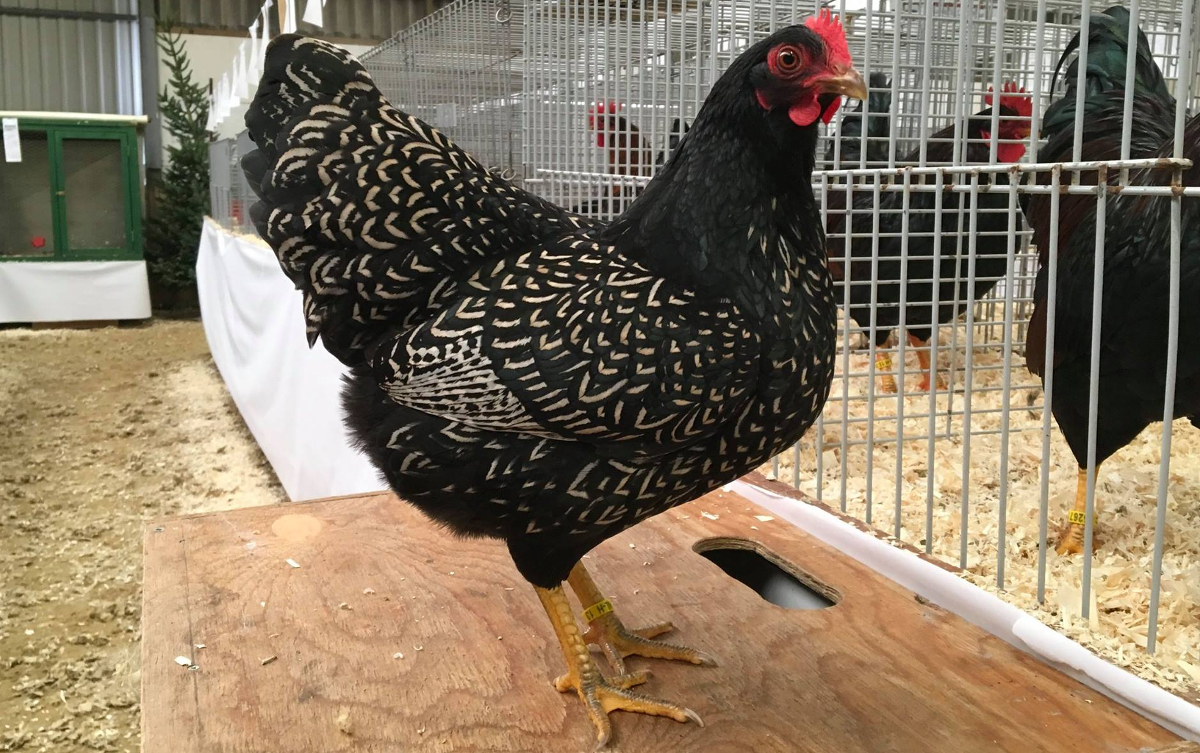
More about one of the recent additions to the Barnevelder stable:
The large fowl Silver Laced Barnevelder is a relatively recent addition to the Barnevelder stable. Good specimens are rare in the UK. The most common fault is the red leakage present in the feathers which causes a saddle of smudginess and discolouration from a subtle yellow red all the way through to full mahogany in some cases.
The Silver Laced Barnevelder makes an excellent backyard chicken for all keepers from the beginner to the more seasoned poultry man.
The silver lays 180 to 200 eggs that tend to be a few shades lighter than the ordinary type.
Below: Silver laced Barnevelder day old chicks.

A day old silver double laced Barnevelder chick - note the stripes on the back.
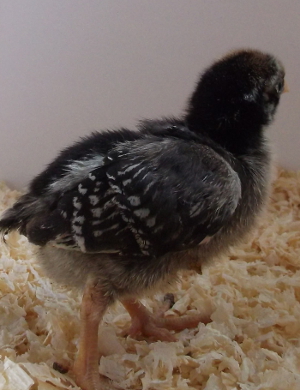
Above: A slightly older chick starting to feather up. the silver lacing is beginning to show in the feathers.
The bird has all the natural traits of the Barnevelder breed, it is bright, amicable, sociable, it is inquisitive and bears confinement well although like all chickens it is best suited to being free ranged.
Silver males are not suitable for showing in the United Kingdom as they need to have laced breast feathers which I have yet to see.
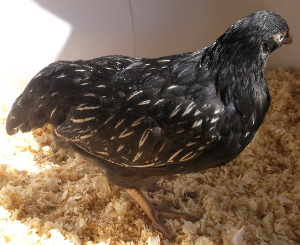
This is a silver laced grower about 8 weeks. Clearly going to be a hen.
See our guide to sexing the barnevelder.There are no such limitation on the continent where a full black chest is preferred. The silver double laced large fowl does not lay a deep brown egg like some other types, mine lay a light brown and sometimes speckled egg. I has the characteristics of the breed otherwise with a solid shell and a good size.
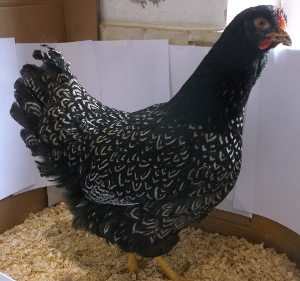
A good example of the breed is an elegant and stunning bird, the white on black has a spectacular effect, and unfortunately problems in the lacing stick out like a sore thumb.
They should conform to the breed standard and have nice yellow legs and a finer comb.
Recreating the Silver Laced Barnevelder:
I bred my own silver double laced Barnevelders, in both the large fowl and the bantam size. In both cases I began with a silver laced Wyandotte. I still maintain a line of Wyandottes in both sizes as I managed to procure a really nice line of birds.
It goes without saying you need to select the bird you breed from well and avoid the runts with hidden unseen characteristics. This was my starting point for the large fowl program. The original was created with a Silver Laced Wyandotte so I chose the same breed as a starting point.
As it turns out I have a friend who breeds Wyandottes and was lucky enough to be gifted a Cockerel. In the past it would have taken several generation to breed out the rose comb as this is dominant, but luckily he had one with a straight comb that I rescued from the pot.
He was set in a run with two really well marked Gold laced hens.
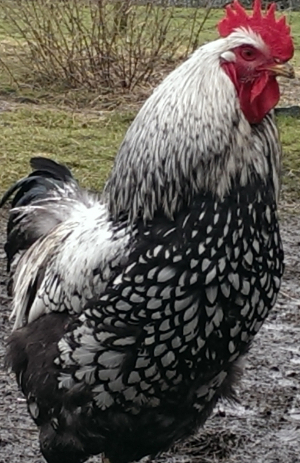
I set about trying to reproduce the Silver Laced Barnevelder for several reasons:
1. Fertility of the males was terrible, we had had several that were completely sterile and most couldn't cope with more than a single hen.
These silver laced Wyandotte bantams were the starting point for my bantam project.
2. There was a lot of red leakage into the silver on the feathers due to poor breeding and crossing back to the standard double laced. We have had some silver Barnevelders in the past that were almost muddy.
3. There needed to be new genes as the silver is so rare it is becoming very inbred. And I do not mean inbred in the way an experienced breeder would line breed birds.
4. They are absolutely stunning.
The results of the first generation were very mixed, everything from almost true Gold Double Laced hens to some quite nicely marked and coloured birds. We selected this one and his brother behind him as they were well coloured and marked. The males were both put in with the best laced hens even if they were muddy and had red leakage.

Choosing which birds to breed from is a conundrum not easily solved. My choice was to choose for colour from the male and pattern from the hen as I knew from my experience in breeding the bantam silver that the red leakage could be bred out over several generations with good selection.
This Rooster below is a 3rd generation:
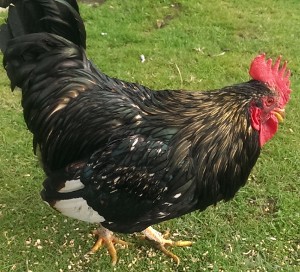
The picture below is a 4th generation hen: Clean and concise lacing but with some red leakage. The males seem to show more red especially in the saddle.
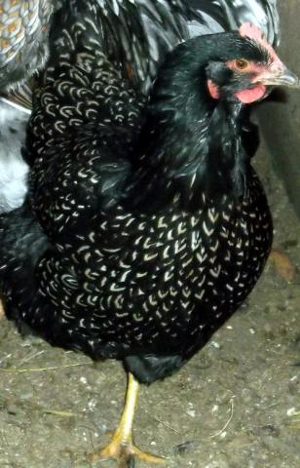
Below is the 5th generation day old chicks:

and late as a 7 week old grower:

It is worth bearing in mind that serious breeders produce a lot of birds that do not make the grade. Make sure you do not end up buying these birds, it is often these inferior specimens that end up in auctions or with general keepers. I have learned that under colour should be selected darker and that a even an amazing specimen of a a male bird will not correct any faults in the lacing of the hens.
It has taken 11 generations in 10 years to reach an acceptable standard.
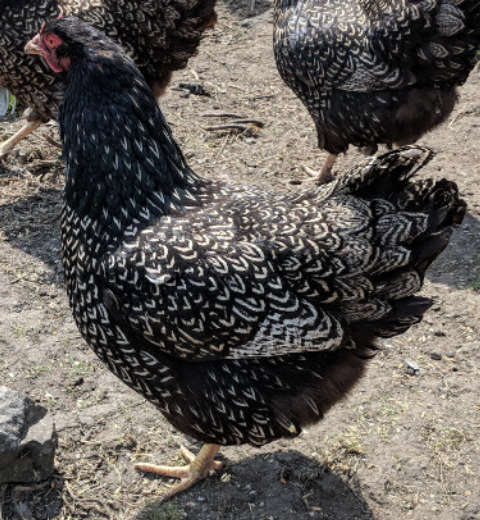
Tips for selecting Barnevelders for breeding:
1. Always select the hens with the best lacing, it cannot be corrected later.
2. Select for dark colours to breed better hens so you may need two pens for breeding.
3. Choose chickens with yellow legs, there is a habit or tendency for the Barnevelder legs to go a deep gold rather than yellow.
4. Breed several pens of different pairs and rotate the hens until you find a sweet combination.
